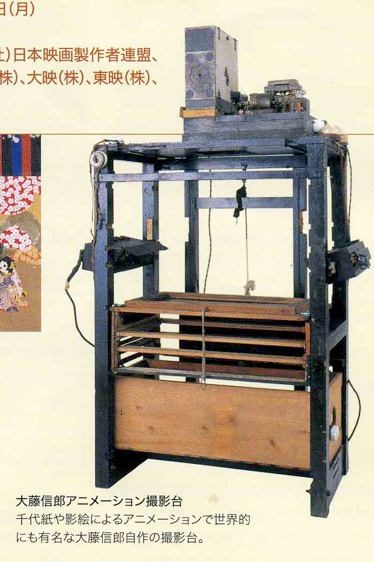Japanese Animation and New Media
Lecture Two: Chapter Two: Animation Stand
The animation stand is the ‘apparatus’ that defines cel animation, in the sense that it is a technical ensemble that brings together a range of technical objects such as movie camera, lights, and celluloid sheets on which images have been inked and coloured. In effect, the animation stand presents a technical formalization of the basic situation of animation production in which you have transparent celluloid sheets that are photographed. Initially, animation consisted of images drawn on paper, photographed, and then projected. With the introduction of transparent celluloid sheets, animators began to use a foreground and background sheet. The foreground sheet usually had the figure or cartoon character, which tended to move. The background sheet had background scenery, which tended to be immobile.
Here is an image of a fairly contemporary and relatively common animation stand, found on line.
The stand is designed to support a camera, to take pictures of an image, probably drawn on celluloid, mounted below under glass. Notice that this camera can move up and down. Side-to-side movement is also possible, but in this instance, it would be easier to produce lateral movement by sliding the celluloid sheet than by moving the camera. The movement of the camera is limited to two directions. As such, creating an impression of movement in three dimensions will prove difficult.
The animation stands used in making cel animation are usually multiplane stands. If you go to the website of Finnish animator, Jan-Eric Nyström, at http://www.sci.fi/~animato/ and look under ‘how a cartoon is made,’ you’ll find an image of a multiplane animation stand. The stand is divided into four levels, each designed to hold a celluloid sheet. This explanation is provided: ‘The filming is carried out on an “animation stand.” Sometimes the picture is divided into several levels (4 on this "multiplane" stand), separated by about 30 cm, or 12". The fore- middle- and backgrounds of the landscape are on different levels, so a certain 3-dimensional effect is achieved, especially when the camera or background is moving.’
Here is an example from Japan, the multiplane animation stand of a famous Japanese animator, Ofuji Noburô.
While the multiplane animation stand does allow for a sense of depth in the image (which Nystrom calls ‘a certain 3-dimensional effect’), this set-up does not make it easy to produce a sense of movement into depth, or ‘cinematism.’ As the camera comes closer to the layered image (the multiplanar image), you won’t produce a sense of movement into depth. Take a relatively simple example with two layers: on the foreground sheet is a cartoon character, and on the background is a barn, with the moon above it in the night sky.
If you want to produce a sense of the character walking toward the barn into depth, you expect, in accordance with experience as well as Cartesian geometry, the barn to get bigger and block out the moon. With this two-layer image, as the camera approaches, the barn does get bigger. But so does the cartoon character. And the moon disappears off the side of the image rather than disappear behind the barn.
So you add a third layer with moon painted on it. Now, as the camera approaches, the barn gets bigger and blocks the moon. But you still have the problem of the character getting bigger. So you have to draw a bunch of images of the character getting smaller and smaller. Or, you have to move the layer with the character painted on it away from the camera as you bring the barn layer closer to the camera.
In sum, with the multiplane animation stand, you introduce effects of depth, but when you move the camera or the celluloid sheets, it is difficult to produce a sense of movement into depth because these multiplanar effects of depth defy the shifts in scalar proportions that one-point perspective has prepared us to expect.
In effect, the multiplane animation stand makes for a tendency toward animetism due to the way in which it brings together camera and images. Yet the camera brings with it another tendency, which comes not merely from the tendencies of the apparatus but also from the practices and conventions associated with it—which in this context I am calling cinematism (movement into depth in accordance with Cartesianism). Why not ignore cinematism and just do animetism? On the one hand, it would be nearly impossible to animate certain kinds of stories and experiences without creating some sense of movement into depth. On the other hand, because of the historical privilege accorded to cinema over animation, animators frequently felt compelled to replicate or mimic cinematic conventions, especially movement into depth.
As a consequence, the story of cel animation is a story of working out a tension between two tendencies or material orientations implicit in the technical set-up of multiplane animation stand—a tensions between cinematism and animetism.




